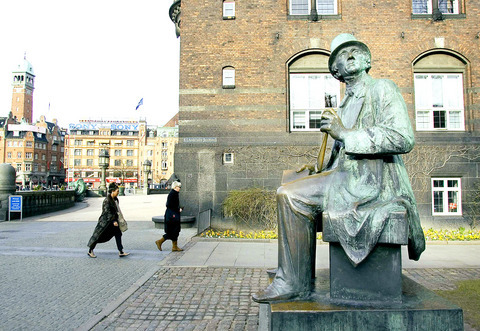In his lifetime, Hans Christian Andersen was Denmark's most famous native son. Yet even after his fairy tales won him fame and fortune, he feared he would be forgotten. He need not have worried. This weekend, Denmark began eight months of celebrations to coincide with the bicentenary of his birth, and Denmark is eager that the world take note as it sets out to define the pigeon-holed writer in its own way.
The festivities began in Copenhagen on Saturday, Andersen's actual birthday, with a lively show of music, dance, lights and comedy inspired by his fairy tales before a crowd of 40,000 people -- including Queen Margrethe II and her family -- at the Parken National Stadium. The opening, called Once Upon a Time, will be followed by a slew of concerts, musicals, ballets, exhibitions, parades and education programs costing over US$40 million.
So more than in recent memory, Danes -- and, they hope, foreigners -- will be reliving the humor, pain and lessons to be found in evergreen stories like The Little Mermaid, The Emperor's New Clothes, The Ugly Duckling, The Little Match-Seller, The Steadfast Tin Soldier, The Shadow, The Princess and the Pea and others of Andersen's 150 or so fairy tales.

PHOTO: EPA
In organizing this extravaganza, of course, Denmark is also celebrating itself. After all, Andersen is still this country's most famous native son. Trumpeting his name and achievements not only draws attention to Denmark's contribution to world culture, but could also woo more foreign tourists to visit his birthplace in the town of Odense and to be photographed beside the famous bronze statue of the Little Mermaid in Copenhagen's harbor.
And Denmark has even more in mind. Local guardians of the Andersen legacy evidently feel his stories have lost ground in recent years to the likes of J.R.R. Tolkien's Lord of the Rings and J.K. Rowlings's Harry Potter. Andersen's fairy tales may remain central to the Danish identity, serving as homespun guides to the vagaries of human behavior, but what about the rest of the world?
"What we really need is a rebirth of Andersen," noted Lars Seeberg, secretary general of the Hans Christian Andersen 2005 Foundation. "Two centuries after his birth, he still fails to be universally acknowledged as the world-class author he no doubt was. In blunt terms, Andersen's fame stifles his wider appreciation. His name puts smiles on peoples' faces around the world from China to the United States, but the smile is one of childhood nostalgia and memories of bedside storytelling."

PHOTO: AFP
Certainly, Andersen himself hoped for more. Having also written novels and plays, he disliked being tagged as a "children's poet." Indeed, while the fantastic quality of his fairy tales appealed to children, their darker elements were often aimed at adults. He wanted to be "a poet of all age groups" and, significantly, when a statue to him was erected on his 70th birthday, four months before his death, he insisted that it show him reading to unseen listeners.
Even at that stage, he saw himself as the outsider he had been all his life. Andersen was born to a cobbler and washerwoman in Odense on April 2, 1805; his childhood love of singing and theater led him to move to Copenhagen at 14. There he hoped to find work as a singer and dancer, but failure prompted him to try his hand at writing. Then, thanks to a chance meeting, he won a scholarship to school and university paid for by King Christian. When he graduated, poor but ambitious, he resumed writing.
But it was not until he was 30 that he wrote his first fairy tales. Published in Denmark in 1836 and across Europe within a decade, The Little Mermaid made his name. Other collections followed, and soon he was being lionized in Copenhagen and beyond. He began traveling widely and also published essays about his wanderings.

PHOTO: REUTERS
Yet he remained an outsider, and it was probably this that enabled him to empathize with many of the losers who appear in his stories. Biographers invariably argue that he identified with the Ugly Duckling -- who was abused for his odd appearance until it was recognized he was actually a swan -- and that he remembered his mother's difficult early years when he wrote The Little Match-Seller, about a girl who ends up freezing to death.
Although a self-made man who could claim to have triumphed against all odds, he was also a loner who appears never to have had a physical relationship with any of the women or men he fell in love with. His repressed bisexuality was long studiously ignored by Danish scholars. Today, it is generally acknowledged here as another example of his complexity.
However, this bicentenary seems devoted less to the tortured writer than to the universality of his stories. To spread this word, the Andersen foundation has named "ambassadors" in a score of countries -- among them Harry Belafonte, Roger Moore, Susan Sarandon, the Brazilian soccer star Pele and the writers A.S. Byatt and Isabel Allende. The foundation and the town of Odense also gave special awards to the German writer Gunter Grass and the American literary critic Harold Bloom.
This international note was reinforced at Saturday's spectacle, Once Upon a Time, which was presented in English and televised in a half dozen countries. Between excerpts from a movie about Andersen's life projected onto three huge screens, singers and dance groups interpreted different fairy tales, starting with Jean-Michel Jarre's light-and-sound version of The Shadow and including Australia's Tap Dogs imagining The Red Shoes. A new UNICEF song composed by Carsten Morch was performed by Hayley Westenra of New Zealand and Morten Harket of Norway. The percussionists Safri Duo of Denmark interpreted The Steadfast Tin Soldier and the Shenyang Acrobatic Troupe of China did a daring version of The Nightingale.
But it was left to two very different American singers to stop the show: Renee Fleming sang O Silver Moon from Dvorak's opera Rusalka to an ecstatic ovation, and Tina Turner had the stadium on its feet with What's Love Got to Do With it.
Strangely absent from the celebrations, though, is almost any mention of Danny Kaye, the man whom many older Americans perhaps most identify with Andersen. Playing the storyteller in Charles Vidor's 1952 movie Hans Christian Andersen, Kaye had a generation of children singing Wonderful, Wonderful Copenhagen. But that fictionalized version of Andersen's life is no longer welcome here.
"The 20th century offered many a sentimentalized version of his life story," Seeberg wrote in an essay for this occasion, "not least in the Hollywood adaptation from 1952 where Danny Kaye depicts Andersen as a sweet, pathetic entertainer, reducing the image of the fairy-tale poet to a caricature: a divinely inspired half-wit. Nothing could be more unfair."

On April 26, The Lancet published a letter from two doctors at Taichung-based China Medical University Hospital (CMUH) warning that “Taiwan’s Health Care System is on the Brink of Collapse.” The authors said that “Years of policy inaction and mismanagement of resources have led to the National Health Insurance system operating under unsustainable conditions.” The pushback was immediate. Errors in the paper were quickly identified and publicized, to discredit the authors (the hospital apologized). CNA reported that CMUH said the letter described Taiwan in 2021 as having 62 nurses per 10,000 people, when the correct number was 78 nurses per 10,000

As we live longer, our risk of cognitive impairment is increasing. How can we delay the onset of symptoms? Do we have to give up every indulgence or can small changes make a difference? We asked neurologists for tips on how to keep our brains healthy for life. TAKE CARE OF YOUR HEALTH “All of the sensible things that apply to bodily health apply to brain health,” says Suzanne O’Sullivan, a consultant in neurology at the National Hospital for Neurology and Neurosurgery in London, and the author of The Age of Diagnosis. “When you’re 20, you can get away with absolute

When the South Vietnamese capital of Saigon fell to the North Vietnamese forces 50 years ago this week, it prompted a mass exodus of some 2 million people — hundreds of thousands fleeing perilously on small boats across open water to escape the communist regime. Many ultimately settled in Southern California’s Orange County in an area now known as “Little Saigon,” not far from Marine Corps Base Camp Pendleton, where the first refugees were airlifted upon reaching the US. The diaspora now also has significant populations in Virginia, Texas and Washington state, as well as in countries including France and Australia.

May 5 to May 11 What started out as friction between Taiwanese students at Taichung First High School and a Japanese head cook escalated dramatically over the first two weeks of May 1927. It began on April 30 when the cook’s wife knew that lotus starch used in that night’s dinner had rat feces in it, but failed to inform staff until the meal was already prepared. The students believed that her silence was intentional, and filed a complaint. The school’s Japanese administrators sided with the cook’s family, dismissing the students as troublemakers and clamping down on their freedoms — with